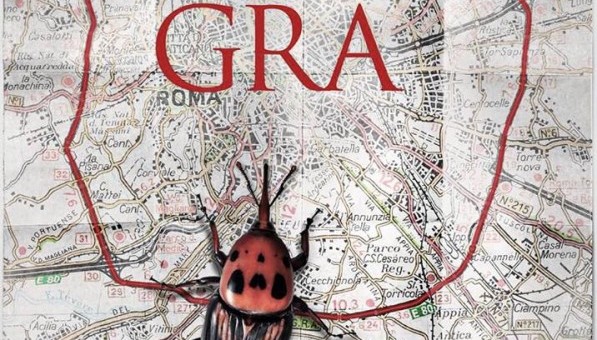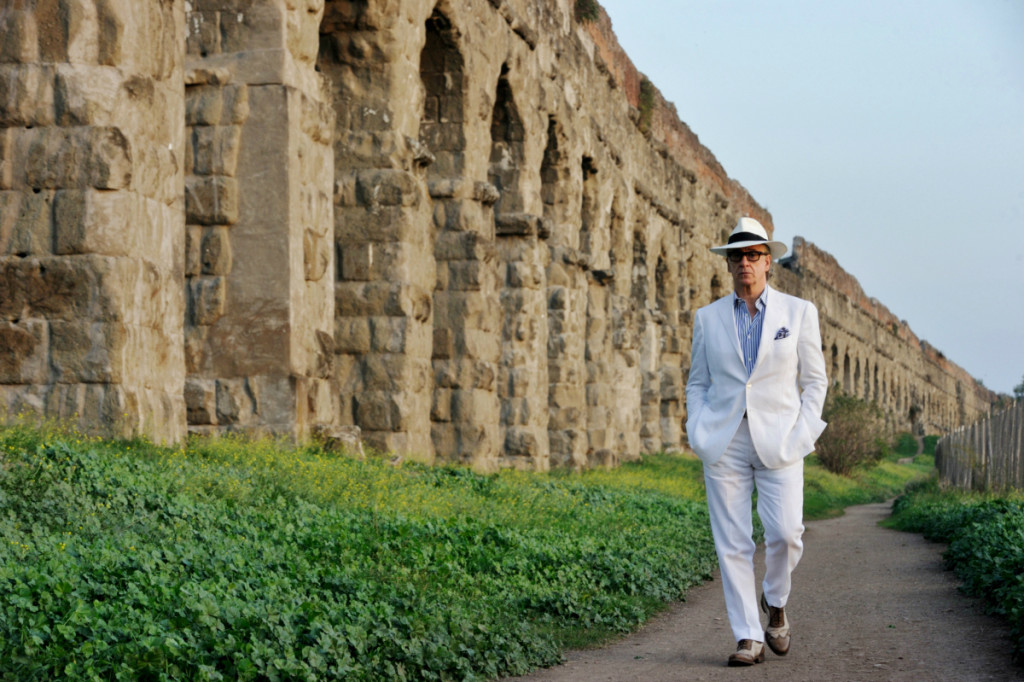“È tutto sedimentato sotto il chiacchiericcio e il rumore, il silenzio e il sentimento, l’emozione e la paura.
Gli sparuti incostanti sprazzi di bellezza. E poi lo squallore disgraziato e l’uomo miserabile.”
Così si chiude “La grande bellezza”, ultimo capolavoro di Paolo Sorrentino. Si conclude così un film discusso, che ha diviso critica e pubblico, dedicato a Roma.
Intenzione del regista napoletano era quella di rifarsi alla Dolce Vita di Fellini, puntando i riflettori sulla società odierna, sulla sua frivolezza e la sua decadenza.
Sorrentino ci porta in un mondo ovattato, lontano dagli occhi comuni; un universo distante dal mercato di periferia e dalla stazione della metropolitana, vicino alla ricchezza, agli eccessi più sfrenati, a una vita dissoluta. La capitale viene rappresentata come bellezza grandiosa, che stordisce i sensi e conduce in un vortice di mondanità, dove non esistono inibizioni, regole e sentimenti, ma solo sorrisi di facciata e feste, che nascondono una povertà culturale disarmante.
Un impero all’alba della sua decadenza.
“Guarda che spettacolo, laggiù c’è il Cupolone. Certo che il Cupolone si vede proprio da dappertutto.
Guarda. Laggiù.”
Non era mai successo che un documentario vincesse il Leone d’Oro. Gianfranco Rosi ci è riuscito con “Sacro Gra”, un film dedicato a Roma. Una Roma esterna però, quella che le cinge il grembo.
Sacro Gra è il Grande Raccordo Anulare, interminabile flusso che contorna la città eterna. Una linea, un cerchio che divide il dentro dal fuori, il bene dal male. Il “Sacro Gra” non ha un inizio né una fine. Luogo di partenza, di arrivo. Di infinito transito, di giri e rigiri. Un cerchio sacro, che non conduce a nulla ma collega tutto.
Nel suo film documentario, Rosi restituisce una Roma popolare e surreale, frutto di anni di studi e osservazione. Il regista, moderno Calvino, si avventura ai margini della città, scoprendo un mondo diverso, vernacolare e incredibilmente reale. Una circonferenza di territorio distante dalla Roma alta e nobile, ma non per questo priva di dignità.
La Grande Bellezza e Sacro Gra sono due film profondamente diversi, ma uniti dalla stessa musa: Roma. Uno la affossa con i suoi eccessi, l’altro la esalta con la sua semplicità. Roma è tornata protagonista del cinema italiano, che riesce a rappresentarla da più punti di vista, ma sempre cogliendo la sua essenza di città passionale e malinconica, capace di attrarre e al contempo di respingere.
Il primo vive di una scrittura serrata, precisa, intransigente e sognante; il secondo, invece, vede la luce giorno per giorno, senza dettami né regole.
Due opere straordinarie per quello che comunicano, per il modo in cui trasmettono il messaggio.
Rosi perlustra un confine di asfalto e lamiere e scopre l’umanità, Sorrentino indaga il cuore della città e non trova nulla, se non qualche evento mondano e tanta falsità.
Una città sproporzionata, mastodontica ma piccola, legata a un passato sempre più pesante.
Freud sosteneva che Roma potesse essere vista come un soggetto umano, “un’entità psichica dal passato similmente lungo e ricco, un’entità in cui nulla di ciò che un tempo ha acquistato esistenza è scomparso, in cui accanto alla più recente fase di sviluppo continuano a sussistere tutte le fasi precedenti”.
È questa la fotografia che ne esce fuori: una città ancorata al suo passato che non riesce a fare passi in avanti, se non in direzioni sbagliate.
E allora Roma è costretta a piangere, per lavarsi di un cambiamento che la sta portando alla distruzione. Non più tempio sacro, solo archeologia di una grandezza antica, che forse non c’è più.
Roma oggi è sola e abbandonata, ma continua a splendere di una luce, la sua, che la rende magnifica. Bellissima e imperfetta.
Un amore senza fine, un’attrazione che fa male, ma che continua forte nei suoi confronti.
Un amore, quello di Sorrentino e Rosi, che permette ai due registi di lasciare in eredità un’immagine forte, malinconica, nostalgica, senza nessun filtro di Instagram.
La Roma di oggi è un po’ sfocata, in crisi. Come Noi.
E forse continuiamo ad amarla proprio per questo.
Piangi Roma, ti fa bene…
[divider]ENGLISH VERSION[/divider]
“It’s all stuck under the chatting and the noise, under the silence and the feelings, under the emotion and the fear. The inconstant flashes of beauty. And then the disgraced squalor and the miserable man.”
That’s how “La grande bellezza”, the last Paolo Sorrentino’s masterpiece, ends. The end of a very debated movie dedicated to the city of Rome, that divided critics and public. The Neapolitans director’s intention was taking leaf from the movie “La Dolce Vita “ directed by Fellini, enlightening the modern society, its frivolousness and decline. Sorrentino brings us in a muffle world, far away from common eyes; an universe distant from the suburbs’ open market and the metro station. An universe close to the richness, to uncontrolled excess and a dissolute life. The capital city is the symbol of magnificent beauty, it befuddles and drives to a vortex of luxury where there are no inhibitions, feelings and rules but just false smiles and parties that hide a disarming cultural poverty. The advent of an empire’s decline.
“Look what a scene, there’s the ‘Cupolone’ down there. You can see it from everywhere. Look. There”
A documentary has never won the “Leone d’Oro” before. Gianfranco Rosi gained it thanks to the “Sacro Gra”, a movie dedicated to Rome. An outer Rome, the one that encloses its core. Sacro Gra represents Rome’s ring road, an endless flux that surrounds the Eternal City. A line, a circle that divides the inside from the outside, the good from the evil. The Sacro Gra has neither a beginning nor an end. It’s a place from where people leave and where they also arrive. A place of endless transit, twists and turns. A holy circle which brings nowhere but links every place.
Rosi in its documentary portrays the Rome of the people, a surreal picture result of years of studies and observation. The director, taking leaf from Calvino, penetrates into the city’s edges, discovering a different world, peculiar and incredibly real. A circular area that is far from the high society but not without dignity. “La Grande Bellezza” and the “Santo Gra” are very different movie but both inspired by the same muse: Rome. The first one underlines its excess, the second one highlights its naturalness. Rome is again the protagonist of Italian cinema that represents the capital from all its different point of view catching its melancholy and passionate essence. Rome is a city able both to attract people and reject them. The first movie is based on an intensify, clear, intransigent and dreamy script. The second one represents a city seen day by day, without any kind of rules.
Two amazing works for the message they convey and for the way in which they convey it. Rosi analyzes the life beyond the asphalt line and he finds the simplicity of human nature. Sorrentino visits the city’s core and he doesn’t find anything besides high society’s events and many lies.
A huge city linked to a very heavy past. Freud thought that Rome could be considered like an human being “ a psychic entity based on a long and rich past, an entity that has all its features still alive and it’s living a development phase that is constantly influenced by the phases it went through in the past”. This is the picture that the movie convey to the public: a city stuck in its past and that keeps going in the wrong way. Rome is forced to cry to free itself from a change that could bring its ruin. Rome isn’t an holy temple anymore and its old greatness is slowly vanishing.
Rome is left to its own, but it is magnificent because it is still shining. Beautiful and imperfect.
A strong endless love toward the city of Rome, a painful attraction. The passion of the two directors Rosi and Sorrentino that push them to transmit a strong and melancholy picture without Instagram’s filters.
The Rome of today is going through a big crisis and it’s confusing. Like we are.
But maybe it is the reason why we still love it.
Cry Rome, it’s good for you…
Traduzione a cura di Teresa Fama





